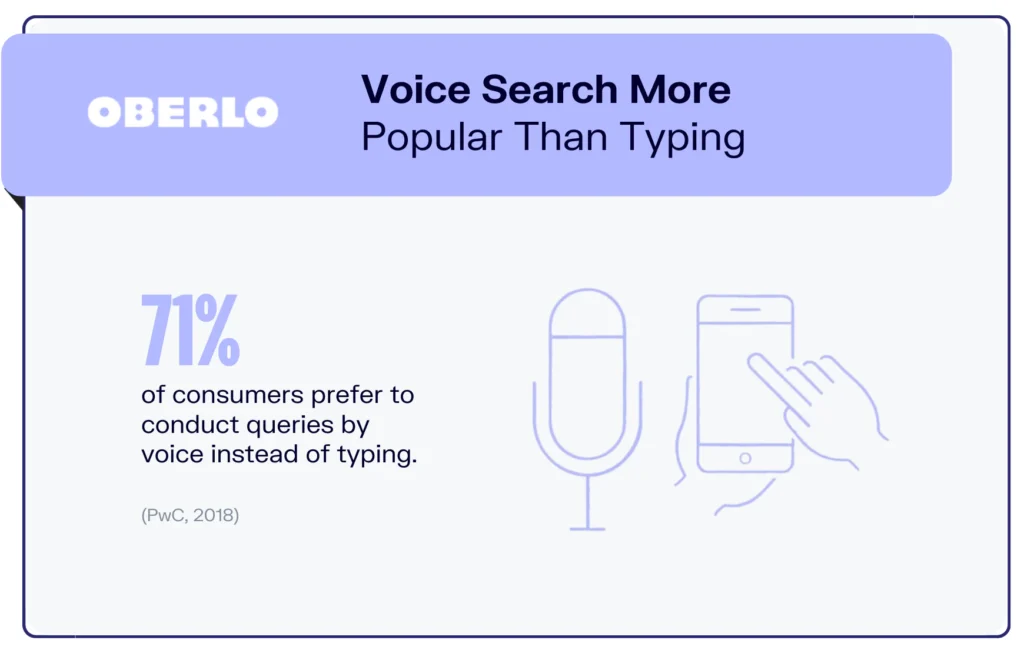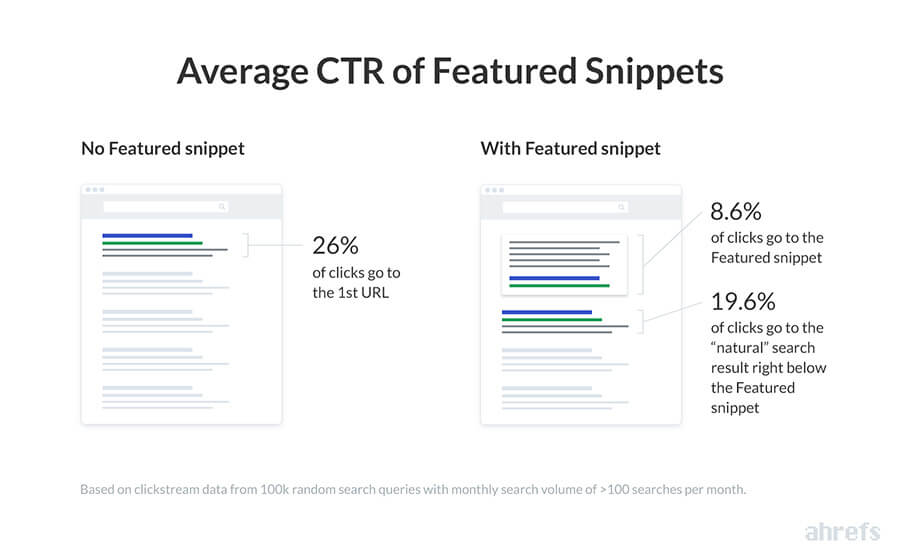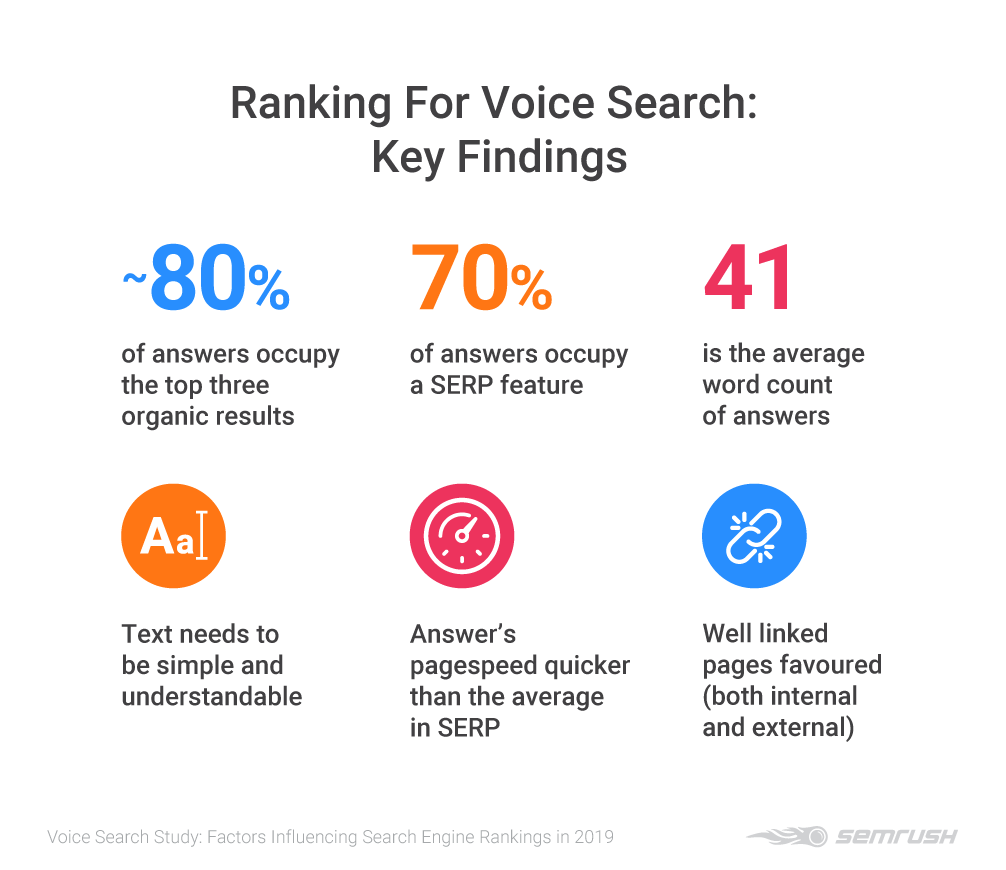The Rise of Voice Search: Optimizing Your Content for Voice Assistants
In a world where convenience is king, the rise of voice search optimization is making waves and reshaping the way we interact with technology.
Imagine asking a question, and your device not only understands but responds with precision – that’s the magic of voice search. And this happens through voice assistants.
So what are voice assistants?
Software programs that recognize and provide responses to human speech are referred to as voice assistants. The majority of voice assistants are stored on smartphones and home devices. They respond to “voice searches” and can be employed to manage email, to-do lists, and calendars, as well as pose inquiries.
Recent stats tell an intriguing tale:
Over 50% of searches will be voice-based by 2024. Yes, you heard that right – the vocal revolution is here, and it’s not slowing down.
It’s also not just about typing queries anymore; it’s about conversing with your devices.
Siri, Alexa, Google Assistant, and Cortana have all melded seamlessly into our daily lives. They do anything from check the weather to make reminders and answer profound inquiries.
These digital assistants have evolved into important companions, bringing comfort despite life’s complexities.
And here’s what you can expect to takeaway from this article:
- Explosive Growth in Voice Searches
- Global Adoption of Voice-Activated Devices
- Smart Voice Search
- Search Behavior Shift
- Local Voice Search Dominance
- Rise of Voice Commerce
So, get ready as we explore the world of voice search, its rapid growth, and how to optimize your content for “future ears“.
1. Statistics and Trends: Riding the Sonic Wave of Voice Search
As we surf the digital tide, it’s crucial to catch the latest stats and trends that reveal the soaring popularity of voice search.
Get ready to explore some stats about how the use of technology is changing.
1. 1. Explosive Growth in Voice Searches:
Recent studies indicate that voice searches are growing at an astonishing rate.
By 2024, projections suggest that over half of all online searches will be conducted through voice commands.
1.2. Global Adoption of Voice-Activated Devices:
Hold onto your hats – there are currently over 4.2 billion voice-activated devices in use worldwide, and by the end of 2024, the numbers are predicted to reach a whopping 8.4 billion.
Smart speakers, virtual assistants, and even our trusty smartphones are becoming our go-to conversational companions.
1.3. Smart Speaker Surge:
Smart speakers are leading the charge in the voice revolution.
Over 150 million Americans currently own a smart speaker, and the numbers are climbing globally.
Devices like Amazon Echo and Google Home are transforming how we access information and control our smart homes.
1.4. Search Behavior Shift:
Voice searches aren’t just a fad; they’re a game-changer.
Users are embracing the hands-free, hassle-free experience of asking questions aloud.
It’s not merely about typing keywords; it’s about engaging in natural, conversational queries.

1.5. Local Voice Search Dominance:
Here’s some good news for local businesses.
Voice searches are three times more likely to be locally focused.
Users are turning to their devices to find nearby restaurants, stores, and services. Hence optimizing voice search for local SEO or local search is no longer a choice – it’s a necessity.
1.6. Voice Commerce on the Rise:
The convenience of voice extends to our shopping habits
Voice commerce, or v-commerce, is experiencing a significant uptick.
Shoppers are using voice commands to make purchases, creating new opportunities for businesses to capitalize on this emerging trend.
1.7. Youthful Affinity for Voice Technology:
The younger generation is at the forefront of embracing voice search.
A substantial percentage of teens and young adults regularly use voice-activated devices, indicating that the trend is set to become even more ingrained in our daily lives.
These statistics paint a vivid picture of a world where voice search isn’t just a feature; it’s a fundamental shift in how we navigate the digital landscape.
As we delve deeper, we’ll uncover the implications for content creators and businesses aiming to stay ahead of the curve in this vocal era of search.
Get ready to amplify your SEO strategy – the sound of success is just a voice command away.
2. Understanding Voice Search: Decoding the Art of Conversational Queries
Now that we’ve got the hang of voice search, let’s uncover how it works.
Voice search isn’t just a technological leap; it’s a shift in how we communicate with our devices.
Get readt as we explore the nuances that set voice searches apart from their text-based counterparts.
2.1. The Art of Natural Interaction:
Voice search flips the script on traditional text-based searches.
Instead of typing a set of keywords, users just have a natural, conversation with their devices.
It’s like having a chat with your search engine, making the experience more intuitive and user-friendly.
2.2. Long-Tail Keywords Take Center Stage:
Forget the short and sweet keywords of the past – voice search thrives on long-tail keywords.
Users tend to ask complete questions or provide detailed commands. This has prompted a shift in SEO strategies.
Content creators must anticipate and cater to these longer, more specific queries.

2.3. Context is King:
Contextual understanding is where voice search truly shines.
Unlike text-based searches that might leave room for ambiguity, voice commands benefit from context.
Search engines strive to comprehend the user’s intent by considering previous queries, location, and personalized preferences.
2.4. Question-Driven Queries:
Voice searches often take the form of questions. Users are more likely to phrase their queries in a way they would ask a friend or a colleague.
Understanding and incorporating these question-driven patterns into your content is key to staying relevant in the voice search landscape.
2.5. Localized Intent:
One of the notable differences is the heightened emphasis on local searches. Users frequently employ voice commands to find nearby businesses, services, or points of interest.
Optimizing content for local SEO becomes imperative for businesses aiming to capture the attention of voice search users.
2.6. Emphasis on Featured Snippets:
Voice search results often rely on featured snippets – concise, information-packed responses that directly answer a user’s query.
Structuring your content to be snippet-friendly increases the likelihood of your website being the voice of authority in response to relevant questions.

2.7. The Rise of Micro-Moments:
Voice search thrives on micro-moments – those instances when users turn to their devices for quick, immediate answers. Understanding these moments and tailoring your content to address them can enhance user engagement and satisfaction.
The stage is set for dialogue-driven interactions, and content creators who master the art of conversation will emerge as the true maestros of the voice search revolution.
3. Unveiling Opportunities: Optimizing for Voice Search:
In the dynamic realm of digital marketing, staying ahead of the curve isn’t just an advantage – it’s a necessity.
The rise of voice search isn’t a trend to observe from the sidelines; it’s a transformative force that businesses and content creators can harness to elevate their online presence.
Let’s dive into why optimizing for voice search is a strategic move that can resonate in the ears of success.
3.1. Consumer-Centric Experience:
Voice search aligns seamlessly with the user’s natural way of communication.
By optimizing for voice, businesses create a more user-centric experience.
The goal is to meet users where they are, catering to their preferences and streamlining the search process.
3.2. A Surge in Mobile and Voice-Activated Devices:
The ubiquity of smartphones and the surge in voice-activated devices mean that users are relying on voice search more than ever.
Optimizing for voice allows businesses to tap into this expanding user base, ensuring their content is accessible and discoverable across various devices.

3.3. Enhanced Local Visibility:
For businesses with a physical presence, voice search offers a golden ticket to local visibility. Users frequently ask their devices for recommendations, directions, and information about nearby businesses.
Optimizing for local SEO and voice-friendly content can position your business as the go-to answer in local searches.
3.4. The SEO Advantage:
Voice search optimization isn’t just about staying trendy; it’s a strategic SEO move.
Search engines reward content that aligns with voice search patterns, providing an opportunity for businesses to secure featured snippets and improve their overall search rankings.
3.5. Improved User Engagement:
Voice-activated devices foster a conversational tone, creating a unique opportunity for businesses to engage with users on a personal level.
Optimizing content for voice search allows brands to establish a rapport with their audience, fostering a connection that goes beyond traditional search interactions.
3.6. Stay Ahead of the Competition:
As voice search continues to gain momentum, businesses that embrace optimization early gain a competitive edge.
Being a pioneer in voice-friendly content positions your brand as forward-thinking and technologically savvy, setting you apart from competitors who are slow to adapt.
3.7. Future-Proofing Your Strategy:
The trajectory of digital trends suggests that voice search is not a fleeting phenomenon but a permanent shift in user behavior.
By optimizing now, businesses future-proof their digital strategy, ensuring they remain relevant and accessible to a tech-savvy audience.
3.8. Harnessing the Power of Featured Snippets:
Voice search results often rely on featured snippets – concise, direct answers to user queries.
Optimizing content for featured snippets increases the chances of your brand being the voice behind the answer, enhancing visibility and authority in search results.
In a world where the voice is the new frontier of search, its important to know that businesses that embrace optimization are not just adapting to change. Yhey are orchestrating their success in harmony with the evolving digital landscape.
The benefits are enormous, and the time to tune in is now.
4. Key Factors for Voice Search Optimization:
Now that you understand the importance of riding the voice search wave, let’s fine-tune our strategy.
Voice search optimization isn’t just about being heard; it’s about being the go-to answer in the spoken word realm.
Here are the key factors that will help you orchestrate your content for maximum impact:
4. 1. Conversational Keywords:
- Tip 1: Embrace the natural flow of conversation in your content. Users express themselves more conversationally when using voice commands, so your keywords should mirror this style.
- Tip 2: Focus on long-tail keywords that mimic the way people ask questions verbally. Consider the who, what, where, when, why, and how aspects of user queries.
4. 2. Featured Snippet Optimization:
- Tip 3: Structure your content to provide concise, direct answers to common questions related to your industry or niche. Voice search often pulls responses from featured snippets, making your content more likely to be selected as the voice of authority.
- Tip 4: Use schema markup to provide search engines with additional context about your content, increasing the chances of being featured in voice search results.
4.3. Local SEO for Voice:
- Tip 5: Optimize your content for local searches by including location-specific information. It is crucial for businesses aiming to capture the attention of users seeking nearby products or services.
- Tip 6: Claim and optimize your Google My Business listing, ensuring accurate and up-to-date information about your business is readily available for voice searches.
4.4. Understand User Intent:
- Tip 7: Dive deep into the psyche of your audience. Understand the intent behind their voice queries and tailor your content to fulfill those intents. Create content that addresses common user needs, concerns, and interests.

- Tip 8: Leverage tools like Google’s “People Also Ask” feature to uncover related questions and incorporate them into your content strategy.
Here’s a quick guide on how you can leverage user intent for your SEO
4.5. Optimize for Mobile:
- Tip 9: Given the prevalence of voice search on mobile devices, ensure that your website is mobile-friendly. A seamless mobile experience contributes to improved voice search optimization.
- Tip 10: Optimize page load times, as users engaging in voice searches often seek quick, immediate answers.
4.6. Contextual Understanding:
- Tip 11: Craft content that anticipates and responds to user context. Voice search relies heavily on understanding the nuances of a user’s intent, so creating contextually rich content enhances your chances of being the preferred voice response.
4.7. Regularly Update and Refresh Content:
- Tip 12: Voice search algorithms appreciate fresh and relevant content. Regularly update and refresh your content to ensure it aligns with current trends and user preferences.
By focusing on these key elements, you’re not just optimizing for voice search; you’re sculpting your content to resonate with the dynamic, conversational nature of spoken queries.
Tune into the rhythm of your audience’s voice, and let your content be the melody they choose to hear.
5. Technical Aspects of Voice Search SEO:
As we venture into the technical realm of voice search optimization, it’s time to uncover the underlying code that can elevate your content to new auditory heights. Buckle up as we delve into the intricacies of schema markup, structured data, and the inner workings of search engine algorithms in the realm of voice search.
5.1. Harnessing the Power of Schema Markup:
A. Understanding Schema Markup:
Schema markup is a structured data vocabulary that helps search engines understand the content on your website more effectively. It provides additional context and details about your content, making it easier for search engines to interpret and serve relevant information.

B. Voice Search-Friendly Markup:
Utilize schema markup to mark up crucial information such as business details, events, product information, and FAQs. This markup enhances the chances of your content being selected as a featured snippet in voice search results.
C. Local Business Markup:
For local businesses, implement Local Business schema markup to provide specific details about your establishment. It includes your address, phone number, business hours, and other pertinent information that aids in local voice search optimization.
5.2. Structured Data for Voice-Friendly Content:
- Semantic Markup and Contextual Understanding: Structured data, particularly in the form of schema markup, contributes to semantic markup. This semantic understanding allows search engines to grasp the context of your content, a critical factor in voice search where user intent plays a pivotal role.
- Events, Recipes, and Q&A Structured Data: Depending on your content type, implement structured data for events, recipes, and Q&A sections. It enhances the likelihood of your content being surfaced in response to voice queries that align with these specific types of information.
5.3. The Role of Natural Language Processing (NLP):
- Decoding Natural Language Queries: Search engines employ Natural Language Processing (NLP) algorithms to comprehend the nuanced and conversational nature of voice queries. Content creators should align their strategy with the way users naturally phrase questions to cater to NLP algorithms effectively.
- User Intent Recognition: NLP helps search engines recognize user intent, allowing them to deliver more accurate and relevant results. Optimize your content to align with various user intents, ensuring that your website is a valuable resource for a range of voice search queries.
5.4. Mobile Optimization for Voice:
- Mobile-Friendly Design: Given the prevalence of voice search on mobile devices, ensure your website is mobile-friendly. Responsive design contributes to a seamless experience for users engaging in voice searches.
- Page Load Speed: Optimize your website’s page load speed for mobile devices. Quick, immediate answers are the essence of voice search, and a fast-loading website contributes to a positive user experience.
Dive deep into mobile optimization with our 12 methods for making your website mobile-friendly.
5.5. Voice Search Ranking Factors:
- Featured Snippets and Concise Answers: Voice search often relies on featured snippets, which are concise, direct answers to user queries. Optimize your content to provide clear, succinct responses to common questions in your industry or niche.
- Local SEO Signals: Local search signals, such as proximity to the user’s location and accurate business information, play a crucial role in voice search rankings. Ensure that your local SEO strategy aligns with the needs of users seeking nearby businesses or services.
- Relevance and Freshness: Search engines favor relevant and up-to-date content. Regularly update and refresh your content to maintain its relevance and appeal to the algorithms that determine voice search rankings.

As we navigate the technical landscape of voice search SEO, remember that the harmony of structured data, schema markup, and algorithmic understanding is the key to unlocking your content’s potential.
FAQs
1 . How does on-page SEO contribute to mobile and voice search optimization?
On-page SEO helps to optimize webpage content for both search engines and users, which improves mobile and voice search optimization.
Important components for increasing visibility and relevance include search intent alignment, title tags, internal links, and URL optimization.
These factors ultimately lead to a better user experience and higher ranks on many platforms.
2. How does voice search differ from text-based searches in terms of context?
Voice search enhances clarity by offering more precise context compared to text-based searches. Users’ intentions are more properly communicated through speech than by typing questions. Location and past interactions are often incorporated into voice inquiries to provide context . This improves the accuracy of search engine results.
3. Why should businesses prioritize voice search optimization?
Voice search suggests a lasting change in user behavior, rather than a temporary trend.
By constantly optimizing, businesses ensure the durability of their digital strategy. This ensures continuing relevance and applicability to a highly connected target audience.
4. To what extent is it necessary to improve voice search’s smartphone compatibility?
Since voice search is becoming increasingly popular on mobile devices, it is imperative that you make sure your website is mobile-friendly. A smartphone experience needs to be smooth in order to be optimized for voice search.
On top of that, since voice search users usually want instant results, website load times should be improved. You can enhance user trust and your website’s presence in voice search results by improving these elements.
5. Why is Schema Markup so important for optimizing for voice search?
Schema Markup works in the same way that labels on packages do. It is added to the code of a site to help search engines figure out what the page is about.
It is usually put in certain places in the code of a webpage to help search engines find it and show it in search results.
Example of Schema Markup: A recipe webpage uses Schema Markup to indicate details such as ingredients, cooking time, and ratings, which helps search engines display rich snippets in search results.
6. What are the voice search ranking factors ?
Voice search ranking factors include:
- Featured Snippets and Concise Answers: Ensure your content offers clear, succinct responses to common questions.
- Local SEO Signals: Align your local SEO strategy with user needs for nearby businesses.
- Relevance and Freshness: Regularly update content to stay appealing to search algorithms.
- Maintain relevance : make sure to appeal to algorithms for better voice search visibility.
Related Posts
Leverage User Intent For Better SEO (And Rank Higher In SERPs)
Making Websites Mobile-Friendly :12 Best Methods
Is the SEO Market Saturated? : Separating Truth from Internet Myths
Blog Commenting For Better SEO: A Surefire Path To Top Search Rankings
Conclusion
In conclusion, the rise of voice search is revolutionizing how we navigate the digital realm.
It’s more than just a passing trend—it’s a fundamental shift.
By understanding the nuances of conversational language and optimizing content accordingly, we position ourselves at the forefront of this evolving landscape.
Voice search isn’t just about keeping pace; it’s about leading the way towards a more intuitive and seamless user experience.
Embracing this shift isn’t just an option; it’s a necessity for staying relevant and competitive in the digital age.

